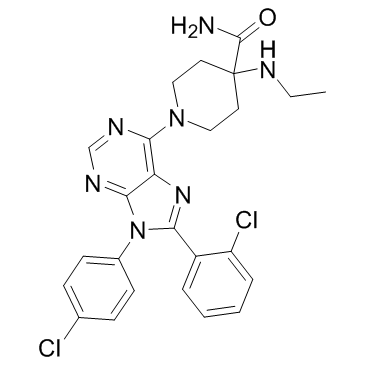
Otenabant
CAS No. 686344-29-6
Otenabant( CP 945598 | CP-945598 | CP945598 )
Catalog No. M15622 CAS No. 686344-29-6
A potent, and selective CB1 receptor antagonist with Ki of 0.7 nM/0.12 nM in binding and functional assays respectively; has low affinity (Ki=7600 nM) for human CB2 receptors; reverses cannabinoid agonist mediated responses, reduces food intake, and increases energy expenditure and fat oxidation in rodents.ObesityPhase 3 Discontinued
Purity : >98% (HPLC)
 COA
COA
 Datasheet
Datasheet
 HNMR
HNMR
 HPLC
HPLC
 MSDS
MSDS
 Handing Instructions
Handing Instructions
| Size | Price / USD | Stock | Quantity |
| 2MG | 37 | In Stock |


|
| 5MG | 60 | In Stock |


|
| 10MG | 86 | In Stock |


|
| 25MG | 165 | In Stock |


|
| 50MG | 294 | In Stock |


|
| 100MG | Get Quote | In Stock |


|
| 200MG | Get Quote | In Stock |


|
| 500MG | Get Quote | In Stock |


|
| 1G | Get Quote | In Stock |


|
Biological Information
-
Product NameOtenabant
-
NoteResearch use only, not for human use.
-
Brief DescriptionA potent, and selective CB1 receptor antagonist with Ki of 0.7 nM/0.12 nM in binding and functional assays respectively; has low affinity (Ki=7600 nM) for human CB2 receptors; reverses cannabinoid agonist mediated responses, reduces food intake, and increases energy expenditure and fat oxidation in rodents.ObesityPhase 3 Discontinued
-
DescriptionA potent, and selective CB1 receptor antagonist with Ki of 0.7 nM/0.12 nM in binding and functional assays respectively; has low affinity (Ki=7600 nM) for human CB2 receptors; reverses cannabinoid agonist mediated responses, reduces food intake, and increases energy expenditure and fat oxidation in rodents.Obesity Phase 3 Discontinued.
-
In VitroOtenabant HCl has low affinity with Ki of 7.6 μM for human CB2 receptors. Otenabant HCl inhibits CB1 receptor with moderate unbound microsomal clearance, low hERG affinity, and adequate CNS penetration.
-
In VivoOtenabant acutely stimulates energy expenditure in rats and decreases the respiratory quotient indicating a metabolic switch to increased fat oxidation. Otenabant (10 mg/kg, p.o.) promotes a 9%, vehicle adjusted weight loss in a 10 day weight loss study in diet-induced obese mice. Otenabant HCl reverses four cannabinoid agonistmediated behaviors (locomotor activity, hypothermia, analgesia, and catalepsy) following administration of the synthetic CB1 receptor agonist CP-55940. Otenabant HCl exhibits dose-dependent anorectic activity in a model of acute food intake in rodents and increased energy expenditure and fat oxidation.
-
SynonymsCP 945598 | CP-945598 | CP945598
-
PathwayGPCR/G Protein
-
TargetCannabinoid Receptor
-
RecptorCB1
-
Research AreaMetabolic Disease
-
IndicationObesity
Chemical Information
-
CAS Number686344-29-6
-
Formula Weight510.4183
-
Molecular FormulaC25H25Cl2N7O
-
Purity>98% (HPLC)
-
Solubility10 mM in DMSO
-
SMILESCCNC1(CCN(CC1)C2=NC=NC3=C2N=C(N3C4=CC=C(C=C4)Cl)C5=CC=CC=C5Cl)C(=O)N
-
Chemical Name4-Piperidinecarboxamide, 1-[8-(2-chlorophenyl)-9-(4-chlorophenyl)-9H-purin-6-yl]-4-(ethylamino)-
Shipping & Storage Information
-
Storage(-20℃)
-
ShippingWith Ice Pack
-
Stability≥ 2 years
Reference
1. Fulp A, et al. J Med Chem. 2012 Nov 26;55(22):10022-32.
2. Hadcock JR, et al. Biochem Biophys Res Commun. 2010 Apr 2;394(2):366-71.
3. Aronne LJ, et al. Obesity (Silver Spring). 2011 Jul;19(7):1404-14.
molnova catalog



related products
-
2-Arachidonoylglycer...
2-Arachidonoylglycerol activates neuronal cannabinoid receptors as a full agonist, and prevents the induction of long-term potentiation at CA3–CA1 synapses.
-
Rimonabant hydrochlo...
Rimonabant Hcl(SR141716A) is a selective central cannabinoid (CB1) receptor inverse agonist with Ki of 1.8 nM.
-
OMDM-6
OMDM-6 is a dual agonist of TRPV1(EC50 = 75 nM) and CB1 (Ki = 3.2 μM). OMDM-6 inhibits anandamide cellular uptake with a Ki of 7.0 μM.



 Cart
Cart
 sales@molnova.com
sales@molnova.com


